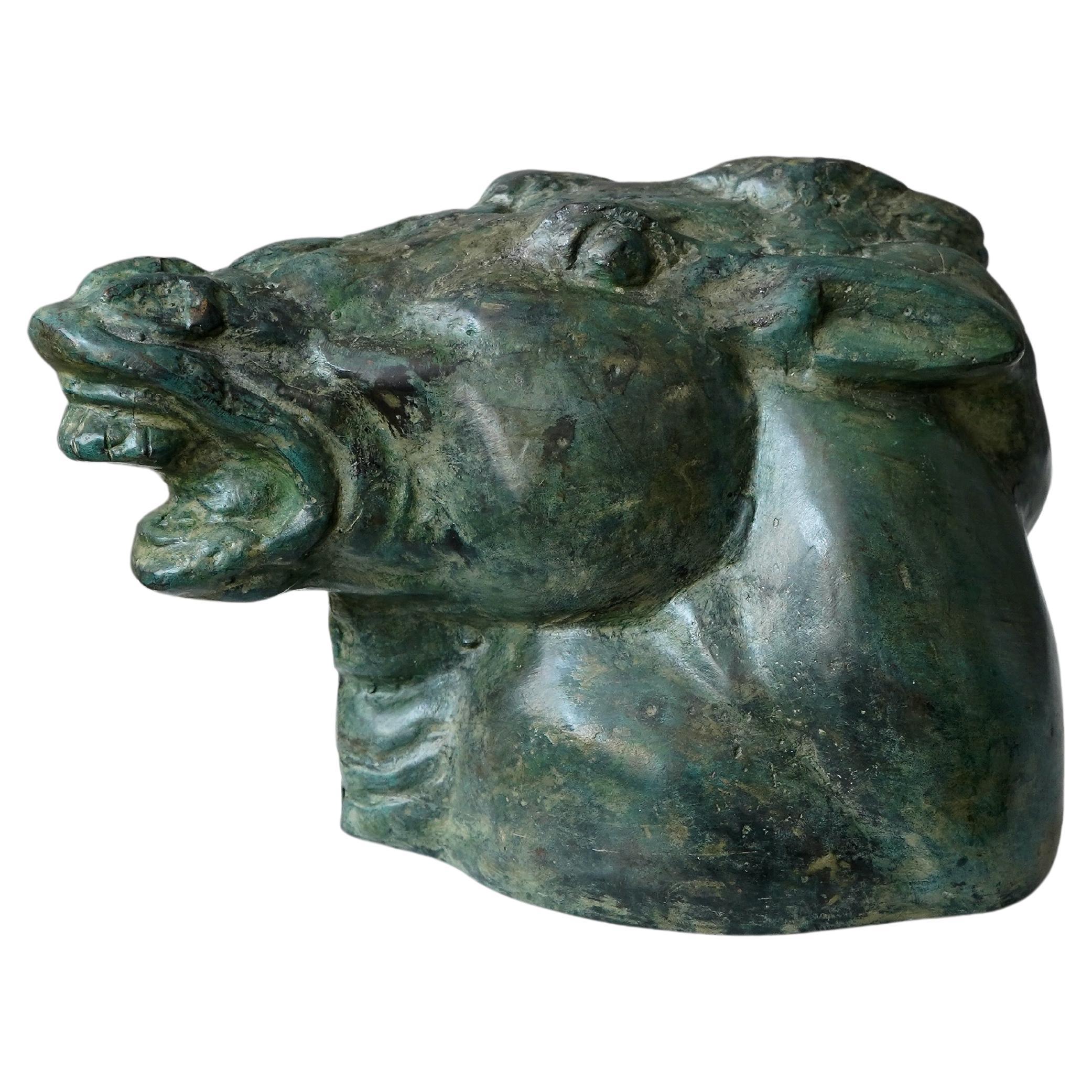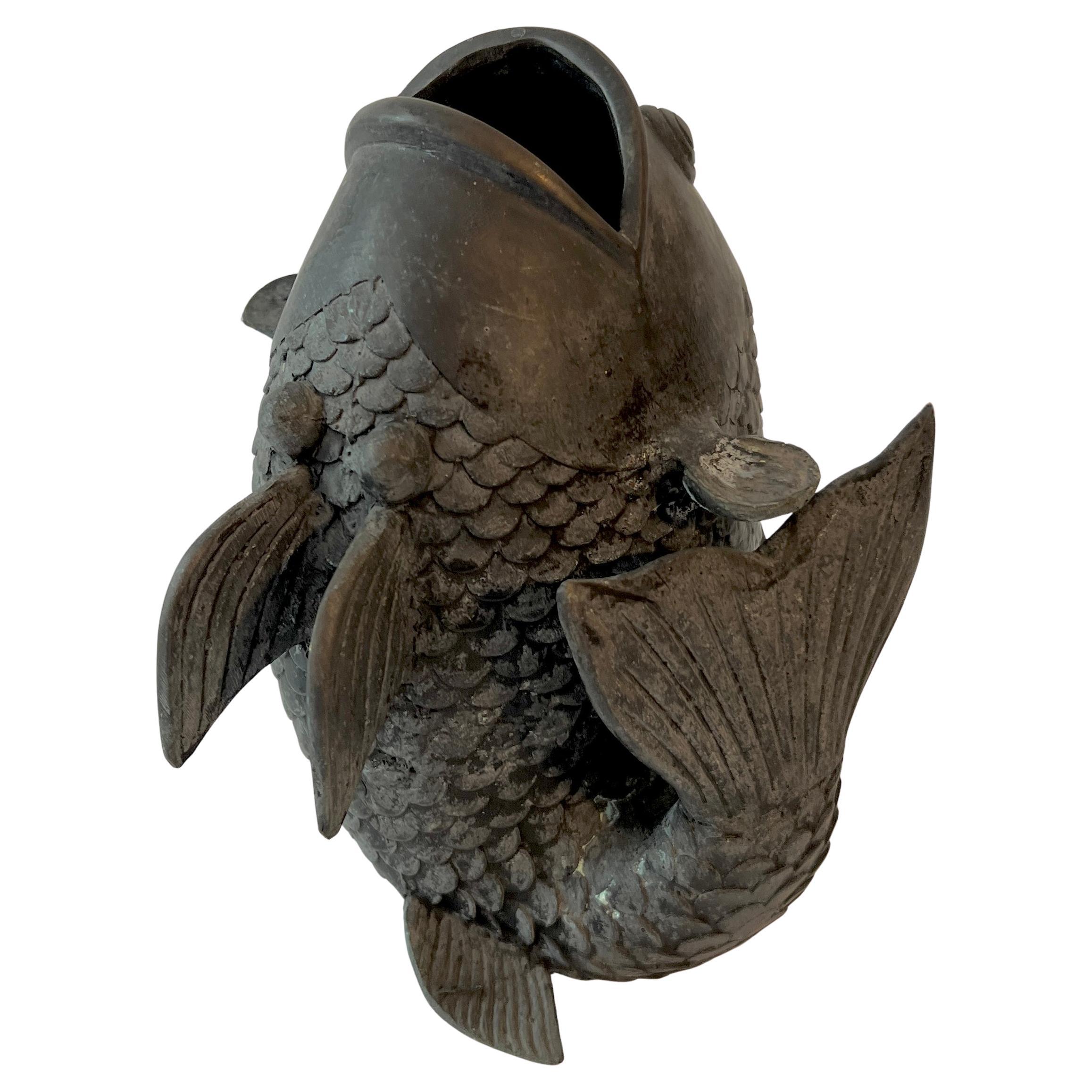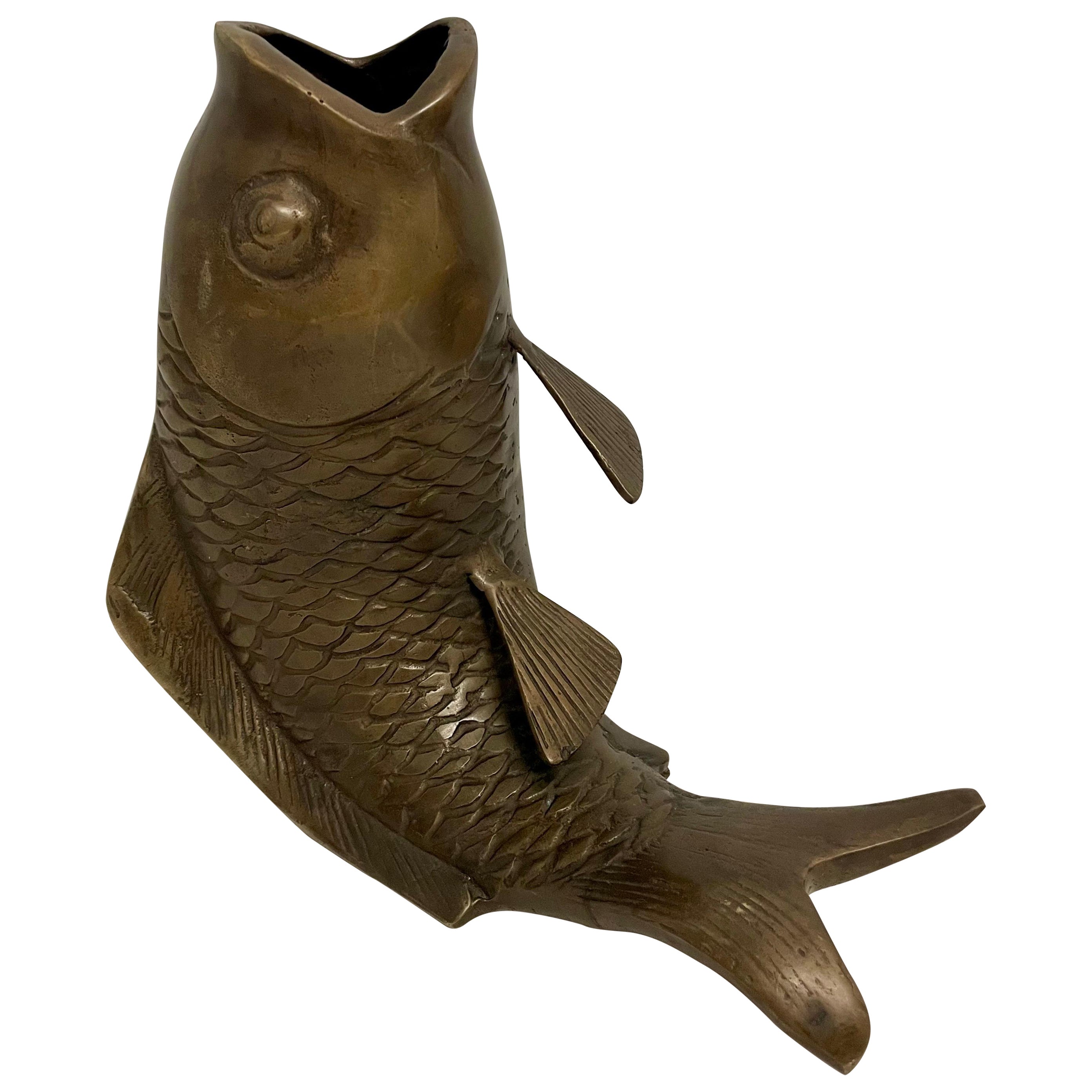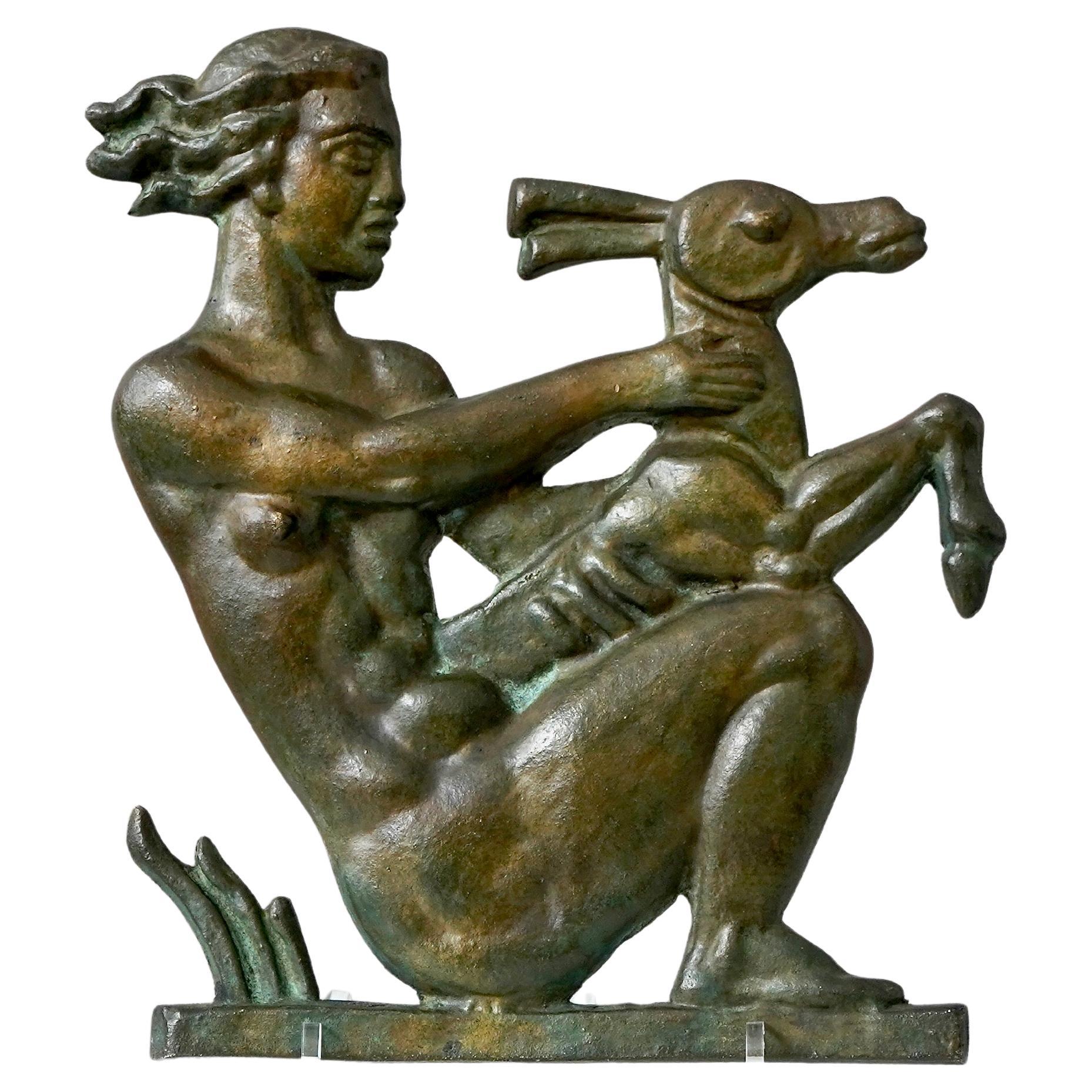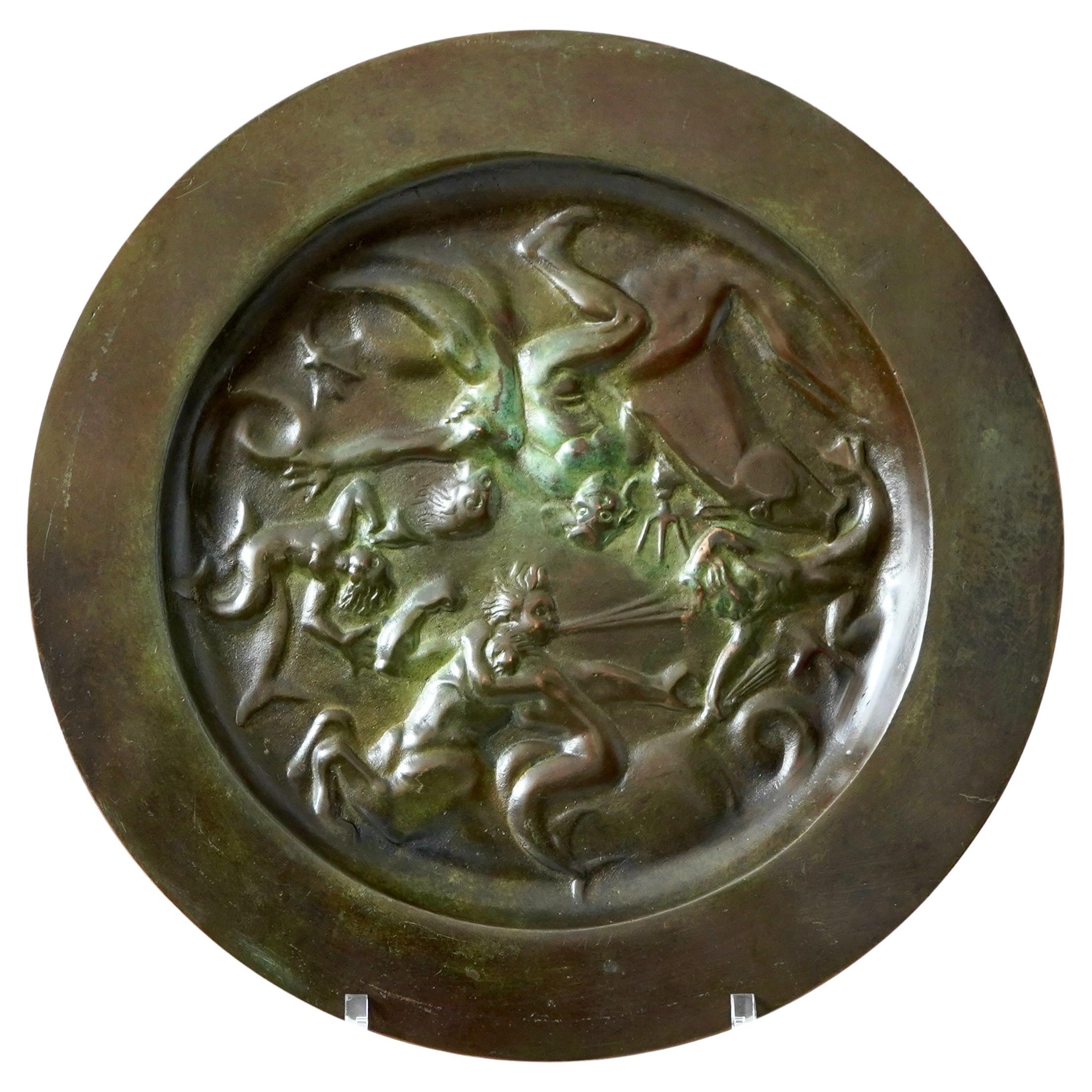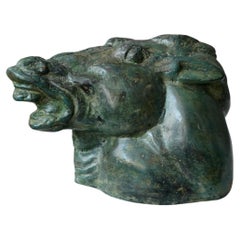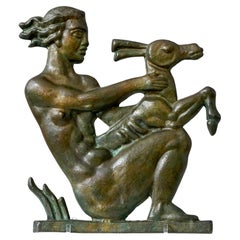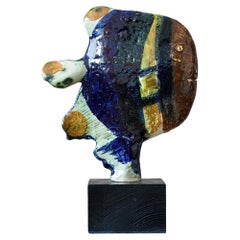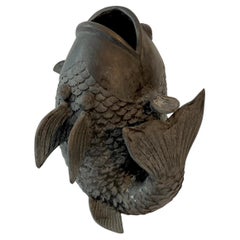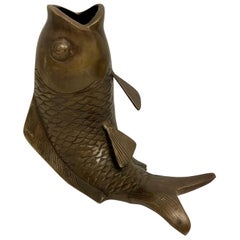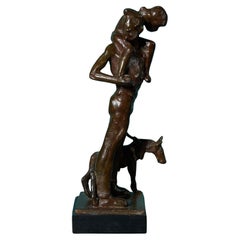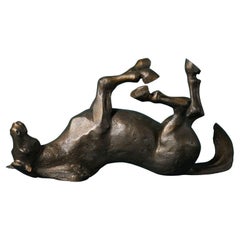Items Similar to Carl Milles Bronze Sculpture of Fishes
Want more images or videos?
Request additional images or videos from the seller
1 of 11
Carl Milles Bronze Sculpture of Fishes
About the Item
Carl Milles (1875-1955), after, bronze sculpture of three fishes. Marked Millesgården.
Great condition.
Born in Uppsala, Sweden, Carl Milles, whose original surname was Anderson, was a sculptor in the classical style of figures and monuments and was a long-time professor of sculpture at the Cranbrook Academy of Art in Bloomfield Hills, Michigan. Many of his works are in that museum.
He first studied sculpture at the Technical School in Stockholm, and then attended the Ecole des Beaux-Arts, Paris and worked in Rodin's sculpture atelier. Before coming to America in 1929, he was "recognized as Sweden's leading sculptor" and was also a professor of modeling at the Royal Academy of Stockholm. However, his unique, flamboyant style offended many persons, which led to his emigration.
In 1945, he became a United States citizen. He did over a hundred public works, mostly in bronze and received many honors including the French Legion of Honor and many honorary doctorates from American and European universities. One of his pieces, Man and Nature, was installed in 1937 in New York City at One Rockefeller Center in the main lobby on the west wall. It is composed of huge blocks of carved Michigan pine, pressed together with glue under tremendous pressure. The work was made at Cranbrook Academy with his students participating in the project. An accompanying silver bird was made in the Cranbrook jewelry studio.
Other venues for installed works by Milles are the City Hall of St. Paul, Minnesota; fountains in St. Louis and Chicago; and a monument in Wilmington, Delaware.
In the 1950s, he returned to Sweden and established the Milles Gardens as a museum for his own work.
Memberships in the United States include the National Sculpture Society and the National Institute of Arts and Letters.
- Creator:Carl Milles (Sculptor)
- Dimensions:Height: 7.29 in (18.5 cm)Width: 6.89 in (17.5 cm)Depth: 2.96 in (7.5 cm)
- Style:Art Deco (Of the Period)
- Materials and Techniques:
- Place of Origin:
- Period:
- Date of Manufacture:Unknown
- Condition:Wear consistent with age and use.
- Seller Location:Malmö, SE
- Reference Number:Seller: 2391stDibs: LU8317239858862
About the Seller
5.0
Platinum Seller
Premium sellers with a 4.7+ rating and 24-hour response times
1stDibs seller since 2023
99 sales on 1stDibs
Typical response time: 1 hour
- ShippingRetrieving quote...Shipping from: Malmö, Sweden
- Return Policy
Authenticity Guarantee
In the unlikely event there’s an issue with an item’s authenticity, contact us within 1 year for a full refund. DetailsMoney-Back Guarantee
If your item is not as described, is damaged in transit, or does not arrive, contact us within 7 days for a full refund. Details24-Hour Cancellation
You have a 24-hour grace period in which to reconsider your purchase, with no questions asked.Vetted Professional Sellers
Our world-class sellers must adhere to strict standards for service and quality, maintaining the integrity of our listings.Price-Match Guarantee
If you find that a seller listed the same item for a lower price elsewhere, we’ll match it.Trusted Global Delivery
Our best-in-class carrier network provides specialized shipping options worldwide, including custom delivery.More From This Seller
View AllCarl Milles Horse's Head Bronze Sculpture
By Carl Milles
Located in Malmö, SE
Carl Milles (1875-1955), after, bronze sculpture of a horse's head. Marked Millesgården.
Great condition.
Born in Uppsala, Sweden, Carl Milles, whose origi...
Category
Vintage 1920s Swedish Art Deco Animal Sculptures
Materials
Bronze
$5,579 Sale Price
20% Off
Rare Swedish Grace Bronze Sculpture. Sweden, 1930s.
By Carl Milles, Herman Bergman, Carl I.E.C. Rasmussen
Located in Malmö, SE
Beautifully sculpted, cast and finished, this 1920s Swedish Grace relief sculpture is made from bronze and has an amazing patina. It was made in Sweden by an unknown artist. Art Deco...
Category
Vintage 1930s Swedish Art Deco Figurative Sculptures
Materials
Bronze
Carl Milles Art Deco Bronze Dish by GAB Guldsmedsaktiebolaget, Sweden, 1930s
By GAB Guldsmedsaktiebolaget, Sune Bäckström, Just Andersen, Carl Milles
Located in Malmö, SE
A beautiful Art Deco / Swedish Grace bronze dish with amazing patina.
'Vindarnas Lek' ('Play of the Winds') designed by famous Swedish sculptor Carl Milles and produced by GAB Gulds...
Category
Vintage 1930s Swedish Art Deco Decorative Dishes and Vide-Poche
Materials
Bronze
Stoneware Fish Sculpture by Carl-Harry Stalhane, Sweden, 1970s
By Carl-Harry Stålhane
Located in Malmö, SE
A rare and beautiful stoneware fish sculpture with amazing glaze, on a wooden base. Made by Carl-Harry Stålhane in his own studio in Lidköping, Sweden, 1970s.
Excellent condition. S...
Category
Mid-20th Century Swedish Mid-Century Modern Animal Sculptures
Materials
Stoneware, Wood
$1,860 Sale Price
20% Off
Enamel Sculpture / Painting by Stig Lindberg, Gustavsberg Studio, Sweden, 1950s
By Stig Lindberg, Gustavsberg
Located in Malmö, SE
A beautiful and rare enamel sculpture / painting. Made by Stig Lindberg in Gustavsberg Studio, Sweden, 1950s.
Excellent condition.
In 1949, Stig painted his first enamel painting o...
Category
Mid-20th Century Swedish Mid-Century Modern Figurative Sculptures
Materials
Enamel, Steel
$6,515 Sale Price
20% Off
Large and Unique Stoneware Rooster by Tyra Lundgren. Sweden, 1955.
By Tyra Lundgren Carolina
Located in Malmö, SE
A stunning and unique stoneware rooster sculpture with amazing glaze.
Made by Tyra Lundgren. Executed in her own studio in Sweden, 1955.
Great condition, but with a couple of chips to the base (pictured).
Signed by the artist in two places, and dated 1955-06-20.
Provenance: bought from the estate of the artist in 1979.
Tyra Lundgren (1897-1979) was one of the most multifaceted artists and modernists of the twentieth century. She was a painter, drawer, sculptor, ceramist, glass- and textile designer, as well as an author and an art critic. She was the first woman who designed glass for Paolo Venini at Murano in Venice and she also served as the artistic leader at Arabia in Helsinki at a time when men tended to hold those kinds of positions.
Tyra Lundgren grew up in Djursholm, near Stockholm. Her parents were John Petter Lundgren, professor at Veterinärinstitutet (institute of veterinary sciences) in Stockholm, and Edith Lundgren née Åberg, who was a housewife and raised their six children. The bourgeois home also comprised a nanny and a female cook. The family were very socially active, travelled often, and enjoyed the outdoor lifestyle. Tyra Lundgren’s schooling began at Djursholm coeducational school, where her teachers included Natanael and Elsa Beskow and Alice Tegnér. Her school friends included Greta Knutson-Tzara, Stellan Mörner, and Ingrid Rydbeck-Zuhr.
Tyra Lundgren knew from the time she was five years old that she wanted to be an artist. She first became aware of the profession through Axel Fahlcrantz, who rented a studio on the plot of land where she lived with her family. In 1913 she began to attend Högre konstindustriella skolan (HKS, now known as Konstfack, college of arts, crafts and design) where she studied decorative art as well as handicrafts in various forms until 1917. One of her fellow students and friends there was Estrid Ericson, who later founded Svenskt Tenn AB in 1924. Whilst attending HKS Tyra Lundgren also took painting lessons at the Althin school of painting. In 1917 she was accepted as a candidate at the Royal Swedish Academy of Fine Arts where, apart from breaks during which she undertook studies abroad, she remained until 1922. She spent a couple of months taking lessons from Anton Hanak in Vienna and from 1920–1923 she was a student of André Lhote in Paris.
Tyra Lundgren was primarily active in four countries: Sweden, Finland, France, and Italy. She spent much of her professional life travelling and considered herself to be a European. Greece and Mexico also formed important centres in her artistic life, as did the USA. She had an extensive social network which included focal individuals within twentieth century-European and American artistic and cultural circles.
Tyra Lundgren’s main artistic motifs were birds, fish, and people which she depicted through different techniques and materials. Her artistic expression involved a variety of different directions and styles. She was a pioneer of the 1920s Swedish Grace style, the name of which had been coined by the art critic Morton Shand at the Stockholm Exhibition of 1930. This was a Swedish Art Deco style, characterised by elegance and traditional art which contrasted with the current artistic ideals of functionalism.
Tyra Lundgren made her debut at a group exhibition held at Kungliga Akademien för de fria konsterna in 1921. She went on to show her work at various exhibitions throughout the 1920s. After that period she only very rarely exhibited her paintings.
Tyra Lundgren’s painted output can be divided into different periods or stylistic directions. The first of these, and the most extensive, was her post-Cubist period which began in 1920 on her arrival in Paris. Her paintings from this time and right up to the mid-1930s typically comprise portraits, self-portraits, live-model painting, still-lifes, interiors, and landscapes in the Cubist style. Many of the great number of self-portraits she painted were produced in the New Objective style, displaying broad variation in terms of clothes, poses and techniques. Two of these – Huvud med vit duk and Självporträtt both from 1921 – can be seen at Moderna Museet in Stockholm, although the majority of these works are at Gotlands Museum.
Tyra Lundgren’s second artistic period comprises the years of 1927 to 1929 and is characterised by the New Objective style inspired by medieval techniques and materials (Giotto, Piero della Francesca). Her motifs were still-lifes and landscapes. At this point she was living in Rome and was close to the circle involved in the Valori plastici: rivista d’arte art journal. This period saw a breakthrough in her development as a painter. From the 1950s through the 1970s her work can almost be described as belonging to the Concrete style. Using light pastel colours her paintings sought light in a sometimes non-figurative expression, but often depicting abstract bird-shapes or other nature-inspired imagery. Her paintings from this period are outsized and display powerful colours, in yellows, reds, and blues.
Tyra Lundgren maintained a constant production of drawings, both in terms of individual artworks and sketches for patterns and designs. She also produced the illustrations for her book Fagert i Fide. Årstiderna på en gammal gotlandsgård, published in 1961. During her early years she also produced advertising illustrations. She spent the final years of her life primarily working with lithographs which were printed at Galleri Prisma and depicted images of doves, swallows, magpies and crows.
Tyra Lundgren is meanwhile best known for her work as a ceramist and in this sphere she was one of Sweden’s leading exponents. She worked in the porcelain industry as a designer and as an artisan and ceramic sculptor. Her first job was at St Eriks Lervarufabrik in Uppsala from 1922–1924, she then worked at Arabia from 1924–1937, and at Rörstrand and Lidköping Porslinsfabrik. She was the artistic leader at Arabia ahead of the 1930 Stockholm Exhibition and she exhibited her work at the World’s Fairs. During the 1934–1938 period she was connected to the Manufacture nationale de Sèvres porcelain factory in Paris.
Tyra Lundgren was a pioneer when it came to giving ceramic art a public space in Sweden. She produced around 20 outsized reliefs in stoneware, so-called monumental reliefs. One of these is Märkeskvinnor, from 1947, for the former girls’ school at Bohusgatan in Stockholm. From the 1940s onwards Tyra Lundgren produced sculptural objects in Chamotte clay and stoneware, with various glazings. Her small birds are well-known and popular with many. When her ceramic efforts became too much for her during the 1970s she then produced models for sculptures in bronze. There are six of these in various places around the globe, including Solfågel in Almedalen, Visby.
Tyra Lundgren began to work as a glassware designer at Moser in Karlsbad in 1922 where she designed new table services and modernised older ones. She also worked freelance for Riihimäki factory in Finland during the 1924–1929 period. From 1934 to 1938 she was employed by Kosta glass factory where she mainly designed thick-walled bowls and vases, engraved with classical motifs. She was introduced to the glassmaker Paolo Venini at Murano during the Triennale di Milano of 1936 and they began a collaboration that lasted into the 1950s. As part of this collaboration Tyra Lundgren became the first woman to design glassware and, in conjunction with the glassblower Arturo Biasutto, she developed new techniques of glass production. Her motifs at this point were birds, fish, snail-shaped designs and leaf-patterned bowls using traditional techniques as well as in new designs. It was during this time that she created the so-called tissue-shaped bowls and it remains unclear as to who specifically came up with the design but Tyra Lundgren claimed it was of her making.
Tyra Lundgren was active as textile designer for Licium (now HV Licium), the sacred textiles...
Category
Mid-20th Century Swedish Scandinavian Modern Animal Sculptures
Materials
Ceramic, Stoneware
$8,330 Sale Price
20% Off
You May Also Like
Bronze Sculpture of a Koi Fish Sculpture Vase
Located in Los Angeles, CA
A Bronze Koi Fish. The beautiful fish can be used as a decorative piece, a vase, and if you're really ambitious, could make a lovely fountain.
A compliment to any space - living ro...
Category
20th Century Japanese Japonisme Animal Sculptures
Materials
Bronze
Bronze Sculpture of a Koi Fish Vase
Located in New York, NY
Bronze Sculpture or Vase of a Koi Fish. Overall good condition, Few spots of patina visible from age and use. Late 20th Century. Felt on bottom
Category
Late 20th Century Japonisme Animal Sculptures
Materials
Bronze
Bronze Sculpture of ’The Meeting’ by John W. Mills
Located in Wormelow, Herefordshire
A unique patinated bronze sculpture titled ’The Meeting’ by the acclaimed British sculptor, John W. Mills, stood upon an integral rectangular ebonised base.
The original life-size s...
Category
Late 20th Century English Mid-Century Modern Figurative Sculptures
Materials
Metal, Bronze
John W. Mills (1933-2023) Bronzed Sculpture of ‘Rolling Horse'
Located in Wormelow, Herefordshire
A sculpture titled the ‘Rolling Horse’ by the acclaimed British sculptor, John W. Mills, signed twice to the tail.
Representing Mill's equestrian art collection, this bronzed resin ...
Category
Late 20th Century English Mid-Century Modern Animal Sculptures
Materials
Resin
Japanese Bronze Koi Fish Sculpture
Located in Houston, TX
Japanese Bronze Koi Fish Sculpture.
This well executed Japanese bronze Koi or Goldfish sculpture has a beautiful patinated verdigris finish and will...
Category
Vintage 1950s Japanese Meiji Animal Sculptures
Materials
Bronze
Indian Bronze Sculpture after Carl Kauba
Located in New York, NY
Indian Chief patinated bronze sculpture after Carl Kauba.
Category
Antique Early 1900s Austrian Belle Époque Figurative Sculptures
Materials
Bronze
Recently Viewed
View AllMore Ways To Browse
Fish Model
Fish Wall Sculpture
Silver Animal Figures
Flamboyant Jewellery
Antique Wall Millors
Carl Mill
Carl Milles
Block Stockholm
Mancioli Italy
Mosaic Rooster
Murano Glass Tiger
Netsuke Turtle
Nouveau Riche
Ostrich Egg And Metal Sculptures
Outdoor Elephant Sculpture
Pair Stone Dogs France
Palatnik Giraffe
Parker Horse
